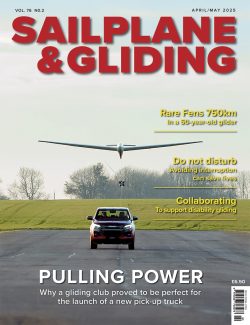Sign up for a new subscription for S&G, pay by Direct Debit and get 50% off your first year’s subscription.
Subscribe Subscriber LoginCurrent Issue
April-May 2025

A 750km from Crowland was a first for both the pilot and the club – it was also flown in a 50-year-old Kestrel. You can read about the flight in the April/May issue of S&G, which also reveals how Hus Bos was transformed for the day to host journalists at the launch of a new pick-up truck. There’s news of a collaboration addressing misconceptions and embracing the vision that gliding is a sport for all, plus a comparison of interruption and distraction with other sectors.
Relatively big flights are rare from Peterborough & Spalding GC, situated on the edge of the East Anglian Fens. Manny Williamson had been watching the forecast all week as, unusually, he would be able to fly on both Saturday and Sunday. Saturday’s flight started well but ended in a field. Sunday was looking good, but with the possibility that convection could end before 6pm. However, not all the forecasts agreed and Manny felt there was potential for the day to go on later than predicted. He came up with a 760km task, with two fallback tasks if the conditions didn’t fit the forecast (or his initial boldness deserted him). It turned out to be the day that everything worked out and Manny flew for almost 9½ hours to complete the task. For the last hour and a half, he thinks he was the only glider airborne in the UK. Manny’s first 750km, and the first 750km out of Crowland.
When The Gliding Centre was approached to use its facility as a press day venue, the opportunity promised a unique way to showcase the club’s creative spirit. The event was to launch the 2025 Isuzu D-Max pick-up truck. It was decided that the hangar would be the backdrop for the launch and the pièce de resistance would be launching a glider behind the Isuzu D-Max for a promotional video. The challenge was how to execute this safely, legally and effectively while meeting the creative demands of a professional film crew. With years of experience helping to manage aerial displays with Aerosparx for high-profile events like Formula 1 and the Dubai World Cup, Rob Barsby was tasked with overseeing the project. As a flying display director, display pilot, and the CFI at The Gliding Centre, he had the best blend to help combine creative ambitions with aviation reality and safety.
A recent survey of all BGA clubs asking questions about how they work with pilots with disabilities made it obvious that there were many misconceptions and myths, for example clubs believing they had to invest in expensive equipment. The BGA subsequently provided an online ‘myth busting’ seminar for clubs, superbly presented by Aerobility’s CFI Al Rosser and CEO Mike Miller-Smith. The BGA is now working closely with Aerobility – who offer disabled people the opportunity to fly powered aircraft – to raise awareness and develop the opportunity to deliver additional Aerobility activity through gliding clubs. BGA Disability Advocate Yvonne Elliott highlights some inspiring stories described by glider pilots with disabilities flying at BGA clubs. A new trophy – the Mike Miller-Smith Wings of Endeavour, presented to an individual with a disability who has been nominated by their peers – was presented to Clare Johnston of Walking on Air/Portmoak at the BGA Sporting Conference in February.
When Paul Jessop found himself in hospital, he was intrigued by the tabard worn by the ward sister one evening. In big letters front and back were the words “Do Not Disturb – Drug Round In Progress”. Clearly someone in nursing had recognised the damaging power of interruption and was trying to prevent drugs being assigned to the wrong patients or in the wrong doses. Paul explains that in rigging gliders, as with dispensing drugs, letting small things get forgotten or leaving things unchecked can be catastrophic. In 2024 there were three incidents that appear to be linked to rigging errors. Paul says we need to learn collectively that it isn’t rude to dismiss idle chat, and that it could prove lifesaving.
Also in this issue: Gillian Wills is in the spotlight for our pilot profile. Andrew Watson and Ed Downham provide an update on Airprox involving gliders. Andrew Jarvis reflects on unexpected mail leading to more vintage adventures. How the Gliding App is helping Essex GC approach the implementation of SFCL regulations. Grimshaw encounters ‘corporate spiffyness’. Kevin Atkinson looks at failings of some YouTube soaring ‘guidance’. John Allan achieves Gold height, completing his Gold badge. Highlights of the BGA Sporting Conference. Alison Randle looks at keeping on top of the invisible tasks at clubs. Pete Stratten provides an update on Sailplane Flight Crew Licensing. Plus, many more of your stunning images in the Gallery pages.
Fly safely and have fun
Susan Newby
Editor, Sailplane & Gliding
Pilot profile: Rita Jefferies
In the spotlight for this issue’s Pilot Profile is Gillian Wills, legendary retriever, who has driven with a trailer for over 500,000km. Now living mainly in New Zealand, Gillian was an instructor and tug pilot, flying from Booker GC, when she met husband Justin
The day that everything worked out
One day last summer turned out to be perfect for a Kestrel 22 that found itself a long way from the Fens in the first 750km ever to be flown from Crowland. Manny Williamson tells the tale
It’s time to upgrade your FLARM
Andrew Watson and Ed Downham provide this year’s annual report on Airprox involving gliders. They advise that the single most effective measure you can take to reduce your Airprox risk this year is to upgrade your FLARM installation to one with 1090 Mhz receiver option.
Click here for a list of the gliding-related Airprox between July 2023 and July 2024
Myth busting
Aerobility and the BGA work together to support disability gliding, address misconceptions, and embrace the vision that gliding is a sport for all. Yvonne Elliott reports
Vintage mailbox
VGC President Andrew Jarvis reflects on unexpected mail leading to more adventures
Meeting the challenge of compliance
Insight from instructor Harry van de Noort, who has flown regularly in the Netherlands, is proving beneficial to Essex GC as they approach the implementation of SFCL regulations
Lasham’s new clubhouse… and a scary dive into the subconscious
Grimshaw encounters corporate spiffyness in Advisory 41
Atkinson’s law: YouTube errors
Kevin Atkinson highlights failings on some YouTube soaring ‘guidance’
High-flying adventure
Husbands Bosworth Airfield proved the ideal venue to film the promotional video for the 2025 Isuzu D-Max – an excellent example of showcasing The Gliding Centre’s creative spirit. Rob Barsby reports
Click here to watch the 2025 Isuzu D-Max promo video
Gold in the bag
After a week of WhatsApp chatter and anticipation, promising Dartmoor wave was forecast for a December day resulting in a Gold height for John Allan to add to his distance and duration
Inspiration, education and a fun event
The venue was packed as delegates joined the 2025 BGA Sporting Conference for talks, gadgets and networking
Keeping on top of the invisible tasks
Alison Randle looks at volunteering and how those big and small things that make a gliding club work get done
Supporting seamless transition into SFCL
BGA CEO Pete Stratten provides an update on Sailplane Flight Crew Licensing
Do not disturb
The BGA Safety Team compares interruption and distraction with other sectors
Click here to read previous Fly Right safety articles
Also in this issue:
BGA news; Gliding Gallery; Club Gallery; Club Focus – East Sussex; development news; news; BGA badges; obituaries; incident and accident summaries
Index to S&G Volume 75
Click here to access the index
Subscribe by direct debit now to save 50% on your subscription
Subscribe Now

